Towards a true digital twin for the metal Additive Manufacturing process
On July 4, 2019, Australia’s Commonwealth Scientific and Industrial Research Organisation (CSIRO) sponsored and co-organised a one-day symposium in Melbourne entitled ‘Towards a True Digital Twin’. The event, which followed APICAM 2019, the 2nd Asia-Pacific International Conference on Additive Manufacturing, brought together experts in a range of relevant fields including metal Additive Manufacturing, computational modelling, multi-scale techniques, structure-property relations, machine learning and artificial intelligence, and digital twins of industrial processes. Here, CSIRO Manufacturing’s Dr Dayalan Gunasegaram and Dr Tony Murphy consider the importance of the digital twin in AM and report on some of the event’s key findings.
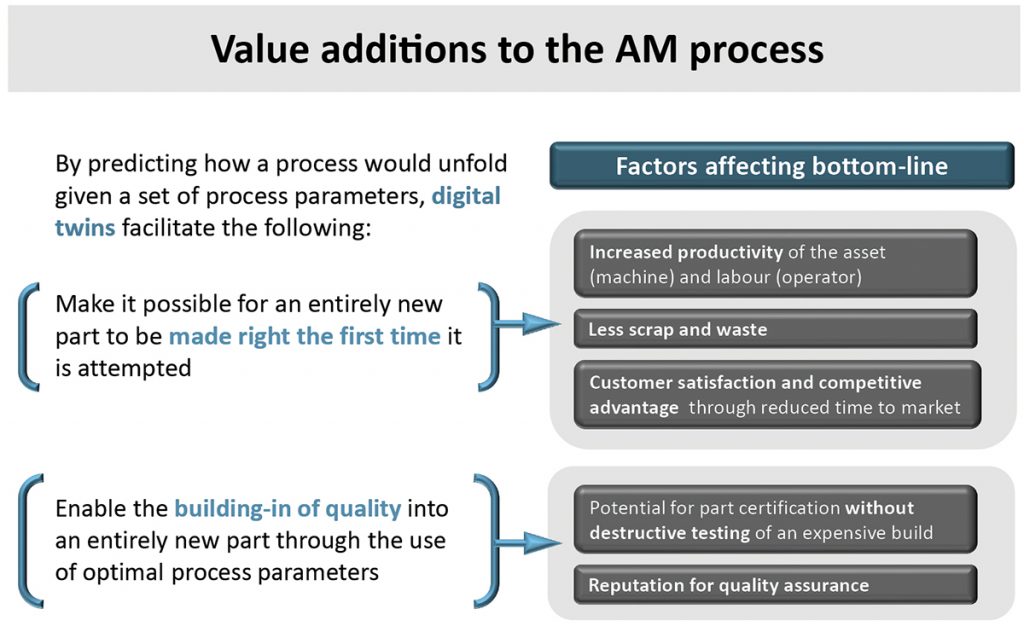
For metal Additive Manufacturing to reach its full potential, a realistic virtual representation of the complete process is required. A ‘digital twin’ that describes the process in the simulated domain will accelerate process design, optimisation and control, and form a crucial part of process certification and component qualification. It is expected that such technologies will be increasingly embraced in the connected economies of the Industry 4.0 era and even become commonplace.
This article draws on presentations and discussions from the Melbourne symposium to explore the requirements of digital twins for metal AM processes, and consider the hurdles that must be overcome in developing them. Ideas exchanged during a road-mapping session are also presented. While the focus of the symposium was on powder bed-based AM processes, most ideas that were exchanged are applicable across a broad spectrum of metal AM technologies.
How predictive modelling will transform AM
Having the ability to control and optimise a process is critical to the successful operation of any manufacturing business. A reliable process ensures quality products that consistently satisfy specifications. This assumes even greater significance in Additive Manufacturing, for which the ability to produce customised parts contributes substantially to the value proposition. This, however, results in products that are unique and relatively expensive. The slowness of the process adds to the part cost through increased overhead per part.
Given this scenario, any business that possesses the capability to produce an AM part right first time has a competitive advantage through reduced rejects, which has the flow-on effects of decreased material consumption, increased productivity and shortened delivery periods.
In addition, if quality can be assured in AM products, the confidence that accompanies the production of each such part can lead to the certification of this part without the need for the destructive testing of an expensive item (Fig. 1).
The challenge is therefore to understand how can such a capability be acquired. Robust predictive modelling capabilities that realistically simulate the AM process and its behaviour can provide the foreknowledge that is required to plan the building of a new part and get it right on the first attempt. That is because the models, or ‘digital twins’, will be able to provide information on how the process is going to unfold for a given set of process parameters. This allows changes to be made to the inputs if it is found that desired outcomes, such as specified part quality, are not going to be achieved. The digital twins can also assist in keeping a process within set boundaries, since any deviations from the optimum path recommended by the models can be corrected through closed-loop control.
Such control is a foundation of Industry 4.0, which differs from the status quo in that it espouses corrective action based on an intelligent analysis of data received from sensors monitoring a process. The process intelligence required for the analysis is provided by physics-based digital twins of the AM process. It should, therefore, come as no surprise that, in the metal AM industry where trial-and-error methods are still widely prevalent, the introduction of digital twins in process planning and control can cause step changes in process productivity and part cost.
About digital twins
A digital twin is a digital model of a real-life object, process or system. Importantly, it is not a virtual model in isolation; it is constructed in such a way as to conduct a two-way information exchange with its physical counterpart, informing and receiving data, for instance from sensors that monitor performance indicators. The aim is to improve the digital twin over time until it becomes a true reflection of its counterpart so that the virtual model can be used in the optimisation and control of the performance of its physical twin (Fig. 2).
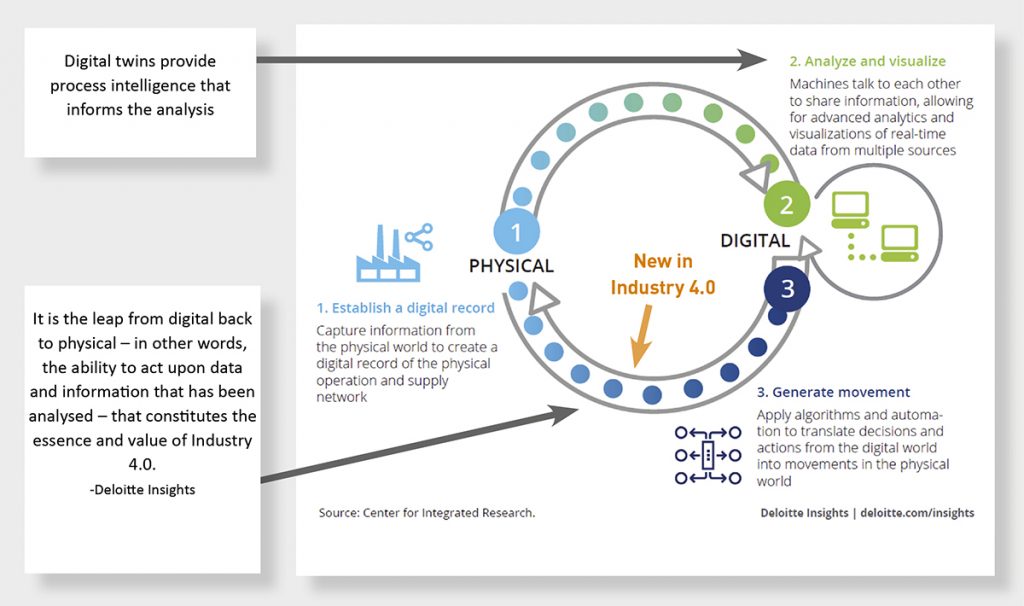
It is worth highlighting that digital twins of processes are a relatively new concept, although twins for products (e.g. GE aircraft engines) and systems (e.g. Tesla automobiles, the city of Singapore) have existed for some time. Even when referring to process twins, most allude to logistical process flow in factories whereas, in our case, we expressly limit ourselves to physics-based models for metal AM processes.
Physics-based digital twins of AM processes

The metal AM process comprises several stages involving complex physical and metallurgical phenomena. For instance, in powder bed systems, these include powder bed raking, heat transfer and flow in the molten pool, microstructure formation and residual stress development (Fig. 3). A complete, end-to-end capture of these various stages in computational sub-models is necessary for a realistic representation of AM in the virtual domain.
These models need to be underpinned by science so that any deviations in inputs from the experimentally validated sets can still be accommodated in predictions. They should not only be accurate and fast, but they have to be tightly integrated with one another. For instance, the output from the powder bed raking sub-model should be available as input to the laser melting sub-model, although the two sub-models simulate completely different physics and thus use entirely different computational methods (Fig. 4).
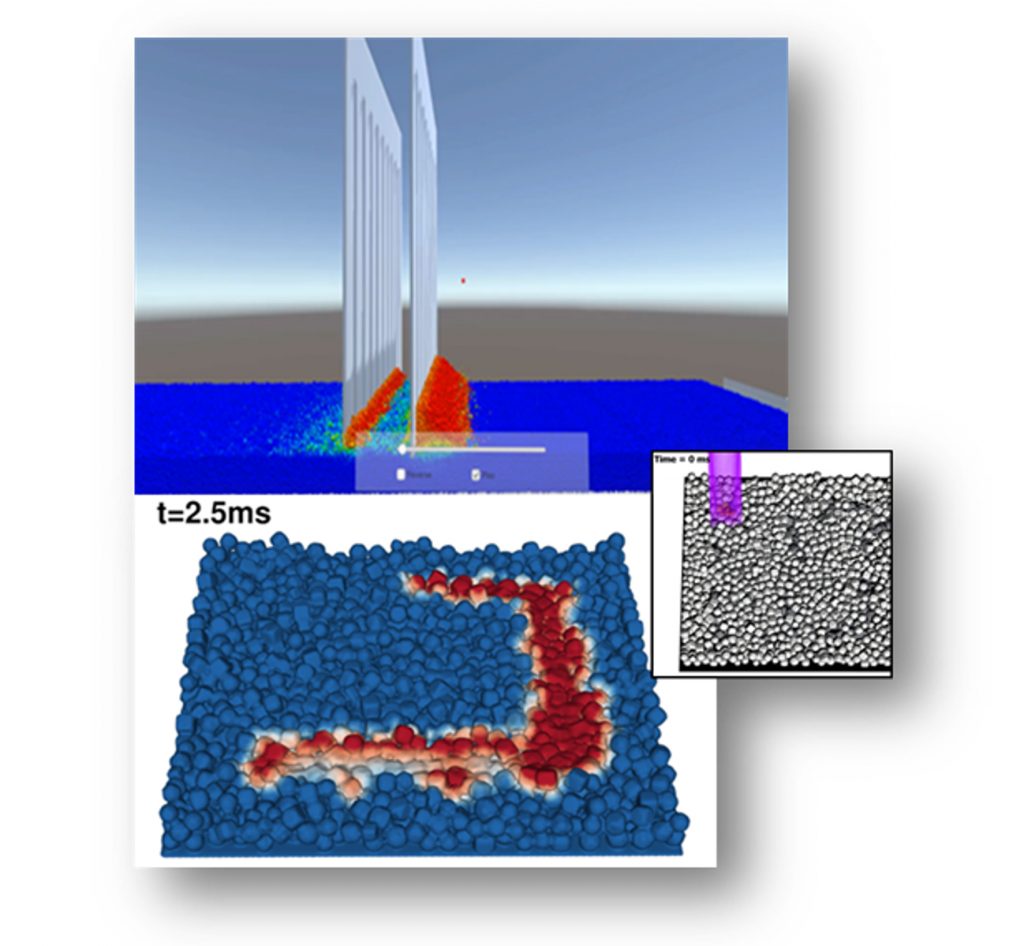
This is a critical obstacle since there are usually incompatibility issues between the mathematical approaches. This is exacerbated by the fact that the sub-models often treat phenomena occurring at vastly different time and length scales, from microstructures (nanometres) to powder (micrometres) to part (up to metres). Thus, considerable collaborative thought and effort are required for the successful development of linking strategies for sub-models that retain much of the solution fidelity when crossing physics as well as scales.
Observations from keynote lectures
Recognising the significance of digital twins to the metal AM industry, CSIRO organised this symposium to bring together international researchers and managers from AM industry players, government bodies and universities. A total of eighty-six delegates attended from Siemens, Boeing, Thales, CSIRO, Defence Science and Technology (DST), Australia’s Nuclear Science and Technology Organisation (ANSTO), Lawrence Livermore National Laboratories (LLNL), RMIT University, University of Melbourne, Swinburne University, Flinders University, Pennsylvania State University, Nanjing University of Aeronautics and Astronautics and University of Texas at Arlington, to name just a few. The event was sponsored by software vendors for ThingWorx, Solvia, Simufact, Materialise and Flow-3D, emphasising the interest from the commercial software community.
The specific aims of the symposium were to define the requirements for a true digital twin of AM, identify the main barriers to developing such software models, discuss potential solutions to overcome those barriers and plan a roadmap that can provide general guidance for the development of digital twins. These aims were achieved through a combination of keynote lectures, poster presentations and facilitated discussion sessions. Keynotes were spread between modelling, experimental validation and machine learning/artificial intelligence for model speed-up purposes.
Some of the main messages from the symposium’s keynote speakers are outlined below. These were the opinions of the speakers, and some may not necessarily be incorporated in the creation of the roadmap.
The use of digital twins in tailoring metal AM processes
The overarching theme of the presentation by Dr Ibo Matthews, Lawrence Livermore National Laboratory (LLNL), USA, was the potential that exists for the use of digital twins in tailoring metal AM processes. A sound understanding of the physics involved, as well as the availability of suitable experimental data for validation purposes, were emphasised as prerequisites for accurate modelling.
The following phenomena were among those listed as needing further in-depth understanding:
- Liquid spatter due to unstable local laser/melt-pool/powder bed interactions
- Depressions in the powder bed due to vapour pressure and pore formation as a result of the highly dynamic interactions and the resulting flow profiles and subsequent solidification
- The effect of all of the above and cooling rates on microstructure evolution.
LLNL is presently studying the use of machine learning (ML) to predict process fidelity (via track width) based on in-situ high-speed video monitoring, but these methods will be later augmented by sophisticated algorithms that can accelerate part certification.
Fundamental physics relating to powder-bed technology and complexity in materials
The main discussion points from the presentation by Prof Leila Ladani, University of Texas at Arlington, USA, focused on the fundamental physics relating to powder bed technology and complexity in materials. The essential take-aways from this presentation were as follows:
- The physics associated with the various phenomena and materials are too complex to be modelled in a computationally efficient way, hence it is advisable to identify a few parameters that have the most influence and concentrate on modelling those influences using suitable simplifications and assumptions, at least for a start (for instance, consider modelling the powder bed as a block rather than as a collection of particles using ‘effective powder thermal conductivity’)
- It is critical to have accurate thermophysical properties, which may be temperature- and/or laser wavelength-dependent
- The research community needs more innovative approaches to be able to model the processes with the lowest computational costs.
Modelling should go hand-in-glove with experimental efforts
In the presentation by Prof Tarasankar DebRoy, Pennsylvania State University, USA, compelling justification was provided for using modelling hand-in-glove with experimental efforts for expanding the knowledge base associated with metal AM processes. DebRoy mentioned that it took the welding community close to a century to develop the knowhow that they currently possess. If we extrapolated that to the AM process, where the number of permutations and combinations in terms of process parameters easily surpasses that of welding, and which is slower and more expensive, it would take much longer to reach that level of knowledge – unless it is done differently.
Difficulties in optimising microstructures, part properties, and control of distortion after a build were listed as key challenges that can be tackled using digital twins. The speaker mentioned that other benefits of using digital twins included:
- A shortened time for bringing a product to market
- Increased chances for introducing process and product design innovations in the industry
- Improved agility to successfully follow market trends and the creation of a process-savvy workforce.
Some of the sub-models that can become the building blocks of a digital twin for metal AM processes were considered, and some hurdles in their development were outlined. These include the lack of a coordinated global approach between the stakeholders who are driven by their own agendas, the unwillingness of large multinational corporations to share knowledge and the difficulty in synthesising the huge amount of data being generated in the field.
Enabling weight reductions in parts
The main thrust of the presentation by Prof Dongdong Gu, Nanjing University of Aeronautics and Astronautics, China, was to bring to the attention of the delegates the importance of the metal AM industry to aeronautics and space in terms of enabling weight reductions in parts (through the design freedom it affords) and the acute need to develop more suitable materials and novel process innovations to achieve this purpose.
Again, the requirement for an in-depth understanding of the science underlying various processes was emphasised, with particular references to particle flow, laser energy absorption, powder melting thermodynamics and surface morphology evolution.
Training machine learning models
Dr Amanda Barnard, CSIRO Data61, Australia, considered the intricacies of training machine learning models based on experimental results and solutions from validated physics-based models. These ‘surrogate’ machine learning models typically provide solutions faster than computationally prohibitive physics-based models, and so are prime candidates for use in real-time closed-loop control as artificial intelligence for data analysis in an Industry 4.0 setting.
Barnard mentioned the requirements for selecting an appropriate, interpretable machine learning model and highlighted the need for combining simulations (predictions) with informatics (inference). She cautioned against the likely traps of biases in data and learning as well as data recording errors, emphasising that surrogate models can inherit (and often amplify) the influences from these.
Possible challenges to creating machine learning models were identified as: insufficient data sets, missing data, outliers and difficulties with feature label extraction (a statistical procedure that deals with potentially correlated variables). One of the most sought-after outputs from machine learning is the ranking of features (structure) by how influential they are in predicting (controlling) labels (properties). It was suggested that one must pay as much attention as possible to the available data, ‘clean’ the data and standardise, as well as attempt to extract as many features (relationships) as possible from it. Models should be cross-validated and optimised to ensure that they make sense in relation to domain knowledge.
The industrial applications of digital twins
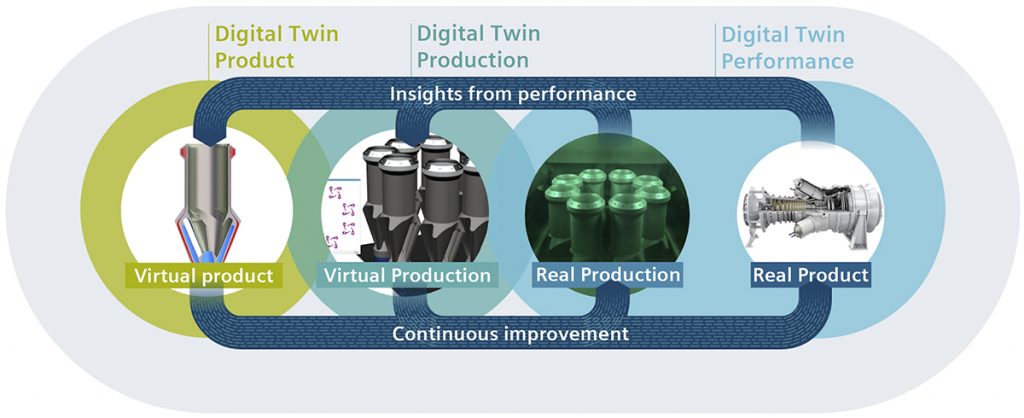
Chris Vains, Siemens, Australia, focused on examples from industry sectors that have already embraced digital twins in non-AM applications. This helped delegates imagine how they might expect the metal AM industry to react to the application of a well-performing digital twin in their own realm. The speaker emphasised the need to create a ‘holistic’ digital twin that encompasses product (design), process (production) and performance in order to facilitate continuous improvements in the delivery of solutions to customers (Fig. 5).
Discussion on roadmap development
In the second half of the symposium, delegates took part in a collaborative workshop overseen by professional facilitators from ThinkPlace, a design and systems transformation consultancy. The aim was to collectively explore the vision, benefits and features of digital twins, the hurdles faced and their solutions within six domain topics suggested by CSIRO. Additionally, the priority of solutions for achieving the vision and the critical path to achieve these solutions – the roadmap forward – was considered. The outcomes of the workshop are summarised below.
Vision
The participants concluded that a digital twin for the metal AM industry should ideally:
- Accurately predict the process and include a multi-disciplinary approach
- Comprise multi-scale models that are robust
- Be validated and reliable
- Be accessible to everyone
- Have links to an open-access database that is updated by scientists globally
- Be able to accommodate a range of materials
- Be able to assist in product design by providing feedback to designers
- Be able to assist in virtual testing by predicting localised part properties
- Be able to assist with closed-loop-control of AM machines
Benefits
The participants saw the potential benefits of digital twins as:
- Enabling the virtual testing and use of new materials sooner
- Enabling the development of new materials for AM
- Enabling the extension of AM products into new applications (e.g. by improving properties through a deeper understanding of influencing factors)
- Allowing the testing of ‘crazy’ ideas in the virtual world, sparking innovation
- Allowing a deeper awareness of production costs
Features
The participants listed the required features of digital twins as:
- Able to predict defects in products or faults in processes
- Capable of arriving at an optimised process
- Able to provide data for surrogate ML models
- Able to deliver solutions for real-time decision-making
- User-friendly so that they can be used by anybody in the product design and production environments
Hurdles and solutions
The participants discussed the hurdles and solutions for the six pre-selected domains as:
- AI and speed of computing for timely solutions
- Experimental data for model validation
- Shortcomings in existing computational approaches
- Lack of material property data
- Difficulties in linking codes (different scales and physics)
- Industry and research partnership
In three round-robin sessions, the participants moved between domains they themselves selected in order to explore the hurdles and potential solutions in those domains. Ideas were recorded onto poster templates, which were subsequently used for the prioritisation of potential solutions.
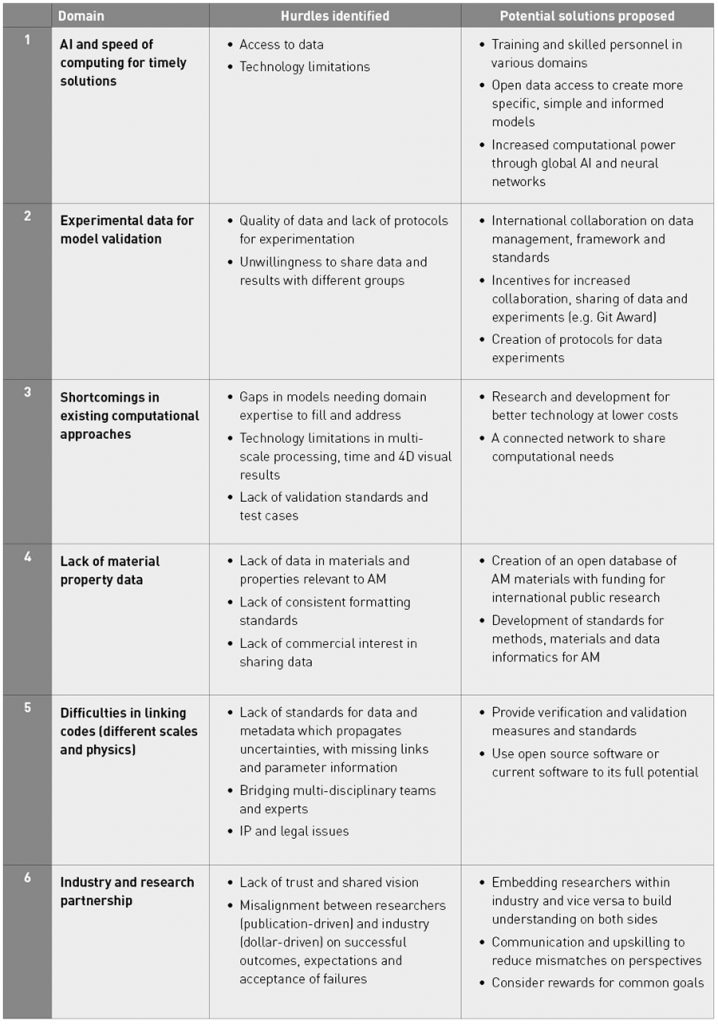
The ideas that were put forward are summarised in Table 1. Priority Solutions and Roadmap are being developed and will be reported on shortly in a separate publication.
Final remarks
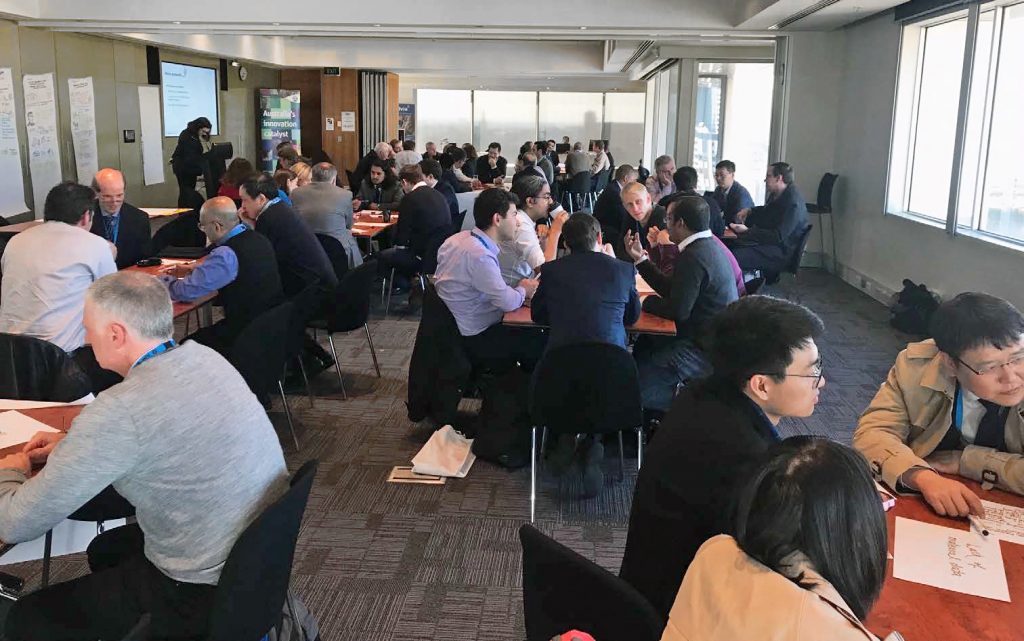
This one-day symposium brought together international stakeholders in the metal AM industry to deliberate on the creation of a true digital twin for AM processes and to exchange ideas towards creating a roadmap. It was abundantly clear from these discussions that the metal AM industry needs computational assistance for several reasons. An overarching requirement is to expand the scientific knowledge base within a reasonable period. An example of a more specific requirement is to support the development of novel AM alloys and associated processes to satisfy strong demand for lightweight and heat-resistant AM structures from sectors such as aerospace.
The participants agreed that a digital twin would significantly help the AM industry, especially as it transitions into the connected economies of Industry 4.0, where the focus will be on productivity improvements in the production process. In a future publication, prioritised solutions, as well as a suggested roadmap, will be dealt with in some depth.
Authors
Dr Dayalan Gunasegaram
Principal Research Engineer/Scientist
[email protected]
Dr Tony Murphy
Chief Research Scientist
[email protected]
CSIRO Manufacturing
Private Bag 10
Clayton South VIC 3169
Australia







